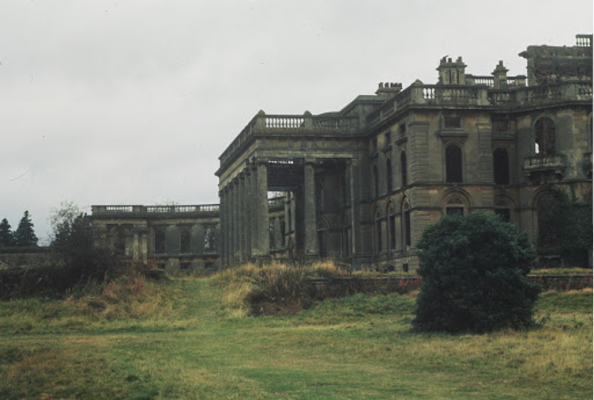Walter Benjamin said of Kafka that his work dealt in ‘the purity and beauty of a failure’. That ‘once he was certain of eventual failure, everything worked out for him en route as in a dream.’ Wresting the Czech novelist from the critics who had variously lumped him into one of two camps – the psychoanalytic or the mystical – Benjamin was keen to assert the far more prosaic origins of Kafka’s absurdity: the ultimate fallibility and smallness of man that ultimately renders all fleeting and often fortuitous achievements, funny.
What Kafka dealt with from an almost metaphysical perspective, became the subject of latter-day comics dealing in the far more kitchen-sink enactments of this same scenario – the petty anxieties of the Petit Bourgeois. This was the social strata rendered humourless by the bald ambition and anxiety that attends climbing the social ladder, becoming an easy target of ridicule along the way. Kafka is the Paul Klee to Tony Hancock’s John Bratby, but the state embodied by both, the sense of wry detachment, and sense of alienation from the systems of governance and bureaucracy that ultimately decide one’s fate, also continued the experience of childhood. I have often marvelled at the ways in which our society maintains the idea that adulthood should constitute the discarding of such scepticism, to me, insisting on a form of delusional and uncritical conformity. The childish amongst us, of which a large concentration seem to exist in the fields of artistic expression and academia, are those who have not yet ceded to the forces of economic one-up-manship, who no different to how we were when we were five, see much of the world as constituting a mystery of jargon and dumb stress.
I have long been interested in the psychic impacts of social mobility. The orphan state it creates in the winners, and the anguish left for everyone else. This state of detachment from bureaucratic forces, the imperviousness to success and failure that I describe here, ought to be the experience of childhood. And yet I wonder whether it was a prelapsarian state cut short for many that inherited Thatcher’s Britain, who became the infant bearers of a system that decided that everyone needed to ‘pull themselves up’. In the 90s, it wasn’t just British parents who were whipped into a frenzy of academic achievement, school catchment areas, private tutors and suspicion of the wrong’un.
This year of stasis has provided ample time to reflect on that experience, although arguably I have been doing very little else for the past few years. It has forced me to ask how I wound up in my early thirties, living alone in a city hundreds of miles away from where I grew up, with little by way of support to lean on in times of difficulty. I have thought too about the deadening of my senses, from a vibrant adolescence of emotional excess to an adult life that can often feel desaturated and dull. Whether this is the inevitable consequence of growing older, or a specific reaction to the conditions imposed on me by a system of politic. Without hope of change, it remains a hypothetical question, though I’ve made no secret of the fact that I believe the current state of play to be sub-optimal, to put it lightly.
Part of this process of reflection has also involved a more concerted effort to excavate certain memories. I have used the opportunity of household confinement to begin a process known as Eye Movement Desensitization and Reprocessing, or EMDR, a treatment recommended to me by various specialists to help with the long-lasting repercussions of domestic violence I’d experienced as a kid, though I’d first heard about it in Bessel Van Der Kolk’s The Body Keeps the Score. Given the growing number of phobias that had also started to beset my life – a fear of confined spaces, a fear of closed doors and a fear of loud noises – I could think of few other productive ways to fill the isolated hours than to test its unorthodox methods.
Since its discovery in the 1980s, EMDR and its mechanical methods of trauma relief have posed something of an existential threat to the psychological profession. By mimicking the REM stage of sleep through the deliberate movement of the eyes, it allows recipients to excavate and re-sort the murkier corners of the memory, exhuming the skeletons of the past from the trigger-happy amygdala, responsible among other things for causing the responses of anxiety and fear, to be placed more comfortably in the cushiony confines of the Hippocampus. In addition to the psychological clarity offered by the treatment, it has also prompted physiological sensations, conforming to Van Der Kolk’s central thesis: that memory is stored as much in the muscles as it is the brain.
Though the treatment is usually administered in person with a therapist moving their finger from side to side, I happily found a man online who was prepared to lead me through the process virtually, instructing me while I crossed my arms and tapped my shoulders. It is embarrassing, but this strange dance has taken place every Monday morning, leading to phases of acute exhaustion followed by a previously unimaginable sense of calm. At the beginning, this was happening while I was also reading, and subsequently thinking about, Annie Ernaux’s Memoire de Fille, a book about the author’s own attempts to excavate the memory surrounding a sexual assault that took place when she was 17 years old.
Gratuitous and absurd as it is to say, it felt at times as though Ernaux and I were on a journey together – our two narratives unfolding in fragments, as both of us switched between the past and present. Ernaux is scared of facing death without having ever told the story of what happened to her as a young woman, and in the telling, processes the many ways that these events have shaped the course of her life. We have both journeyed across the plains of Google Maps – she to the summer camp where she worked in 1958, me to the various family homes we lived in across South Birmingham.
But in addition to the flats and houses of my childhood, I have been surprised by the frequency with which I also returned to another place, gliding virtually along the M5 and a series of B roads, to a stately home known as Witley Court. Once owned by of the Earl of Dudley, a title that now reads like a bad joke, the family ran into financial hardship and sold the house in 1920 to Kidderminster Carpets, a company most familiar to local residents for its earworm of a radio jingle (Kidderminster Carpets won’t be beaten on price). The first known building on the site was constructed during the seventeenth century. In the nineteenth century the house underwent a large expansion, adding a neoclassical portico and several other features designed by John Nash, the architect famous for the Brighton Pavilion, the Marble Arch and Buckingham Palace. The fact that such a building should exist in the rather more staid environs of the greater West Midlands – along one of the vast tributaries carrying Brummies away from their native city and into the surrounding countryside – is quite remarkable. Even more remarkable is the fact that in 1937, and under the auspices of the carpet company, it was ruined by a fire, only to be partially restored in the late 1990s.
For over half a century, the vast house stood empty and untended to. Despite a precursor to the English Heritage acquiring the property in the mid-1970s, it took almost thirty years for restoration work to take place, meaning that the house my parents and I discovered was one of decrepit proportions; a Midland Manderley, only a few miles from a pub where my grandma had recently assumed the post of manageress. The Fountain was a vast Tudorbethan monstrosity, and just one in a series of establishments that Nan lived in and managed as an employee of the brewery Mitchell & Butler. From the flat-roof Sugarbrook to a crumbling building at the entrance to Elgar’s birthplace, these odd receptacles of human indulgence offered a rare opportunity for us to enjoy a regal quantity of space, at least in the hours between openings. My cousin Sophie and I had the freedom to run the length of the carpeted bar area or hide out in the toilets until men with matching pleather faces and coats would leer down at us again from the bar. In these small palaces of pain and perjury, indiscretions took place in dark corners, and local neighbourhood feuds were fought in the car park. At The Fountain a man killed himself in his car, gassing himself as Nan discovered the following morning.
Where I grew up, there was a sense of violence lurking everywhere. The spectre of red-faced men – and it was always men, ravaged by unemployment and shame, drugs and heavy drinking – creeping in by whispers; stolen phone calls and the friends who would mysteriously disappear from school for weeks on end only to reappear with yellow marks on their faces or mottled skin from an errant kettle.
Witley Court was a place that afforded us space from all that. When we first discovered it, the house was unfenced, accessible and free to anyone who knew about it, and we seemed to be the only ones. English Heritage now charges £10 a head to access the grounds, a cost that makes entrance prohibitively expensive for most working families. It’s a galling development, particularly in light of the fact that English Heritage received £80 million in government funding in 2015 alone, while domestic violence services have been left to fall into ruin. In 2018 it was reported that the coalition government had been responsible for a £7 million loss of funding to domestic violence services around the country. By 2018, and as a direct consequence of austerity cuts to both the charity sector and local authorities, the Women’s Aid Annual Audit found that 64 per cent of refuge referrals were being declined. That has left us woefully unprepared to protect the most vulnerable women as we enter successive lockdowns. Despite the English Heritage having also borne the brunt of austerity, and endured a repairs deficit of £100 million following the installment of the coalition government, its financial support still far outstrips many vital services.
The current moment has been a long time coming. In 1983, Tory MP Michael Heseltine authorised a semi-autonomous entity to manage the UK’s historic environment. At the same time, several regulatory bodies tasked with overseeing the ethical and political management of the country’s historic sites were coalesced in a commission that would be the first iteration of what we now refer to as English Heritage, an adaptation (whose jingoistic overtones were self-evident) of The Historic Buildings and Monuments Commission. Since then, the organisation has assumed several guises as it’s been shuttled between quangos and government departments. In recent history alone, responsibility has been transferred between the Ministry of Public Building and Works, the Department of the Environment, and the Department for Digital, Culture, Media and Sport. In 2015, it became separate from Historic England, responsible for the listing and protection of the country’s historic environment. In each instance the lines have been redrawn to ensure a further privatisation of public space, while the listing of certain buildings, and the classification of ‘historic significance’, has been deeply rooted in the neoliberal economics that have reigned supreme. Mid-century modernism aimed at the collective still suffers from the ignorance and bigotry of the executives, and buildings of great civic and artistic importance, such as John Madin’s Central Library in Birmingham, have been committed to demolition. Meanwhile, the exultation of buildings implicated in slavery continues apace, including a large number of country houses, while at the other extreme, a slew of Postmodernist buildings that attended the rampant deregulation of the Thatcher years became listed in 2018. As an organisation, English Heritage has been responsible for entrenching a national identity, one rooted in imperialism and the stubborn denial of the 1960s and 70s.
It’s hard to imagine what the creative landscape of my childhood might have looked like without the house, to which we were essentially trespassers at the time of visiting. Despite both being culturally curious and sensitive people, my parents were raising a small child in a world that had made it almost impossible. My mum, barely an adult, was shuttling me between our council flat in Northfield, South Birmingham, and the nursery school that would eat up most of her pay. My dad worked as a builder. The two main employers in the area were the Rover car plant and an American printing company. Most of my mum’s family worked for the former, she worked for the latter, and while my dad would later join her, going on to pursue the printer’s nightly IT course programme, it would be a long time before their efforts in low-paid clerical jobs afforded them even a small degree of financial security. In the brief clutches of time between drudgery, Witley Court, pre-English Heritage makeover, was our only taste of opulence, as we walked up the stone steps towards the main hallway where we were able to shout at the top of our lungs and enjoy the echo reverberating all around us.
These are the bits of the story that get lost in the process of retroactive grievance and injustice. Trauma flattens the memory, reducing life to a series of stock images that are disjointed and nonsensical, but also erasing the joy that often stretched out over great distances between the islands of terror and shame. A culture of damnation and moral absolutes blots the complicating factor of love and affection. What do we gain by consigning whole people and phases of our life to the dustbin of history? What essential moments of joy are salvageable from the ruins of memory, and necessary for keeping us safe and, indeed, sane?
As Ernaux found, cleaning up the bad parts of the memory brought the good into clearer focus. Just as her narrative swiftly evolves past the initial assault, rejection and humiliation to remembering the friendships that brought her back to life, so my own happier memories started to return as I continued the process over video link. Tracing my past through images retrieved from Google Maps, old property listings and Facebook photographs, but also with the help of the tapping, I have not just been able to retrace the halls of the memory, but to redecorate them, allowing the colour to return to the walls as the feeling returns to the body. Ernaux lost her period for several years after the assault, a phenomenon either caused by the attack itself, or by her subsequent eating disorder. My own has been disordered ever since it first arrived a few weeks after my twelfth birthday.
I still don’t speak to my father – a clear-headed decision not taken lightly, but certainly not taken out of spite. But by recalibrating the architecture of my own experience – constructing memory palaces of the type used in Greek and Roman rhetoric to recall information – erecting passageways between disparate snapshots that hardly made any sense to me before, my dad returns to me as a happier man in his mid-twenties, bright and determined as my mother was, to instil in me a confidence that they were both sadly denied in their own childhoods.
I can see their efforts to expose me to a world of far vaster and more inspiring proportions than the one we’d been confined to by economic cruelty, through the frequent return visits we made to the house whose walls were pervious to the gushes of wind. A space that afforded us freedom from the perpetual grind and agony of social mobility, with its attendant loss of identity and lifelong sense of dislocation and shame. The intention might have been for me to imbibe the same culture as my wealthier peers, and to inspire a sense of ambition for something more. But on reflection it meant all the more for me for existing outside that logic. Decades before I would ever learn the name John Nash, it was a place where we could simply congregate, play and shout without consequence or fear of judgment; just as the rich had done decades earlier, and to such devastating effect.
None of which is possible anymore, even though the lawns are mown and the fountain of Perseus and Andromeda flows with water. The Witley Court I grew up in has long since gone, burnished and perfected in much the way that we were expected to be in order to survive. Yet as Ernaux discovers at the end of her story, there is little to endear us to perfection. The absurdity continues as she writes that, ‘The memory of what I have written is already fading. I do not know what this piece of writing is. Even the thing I was pursuing by writing this book has dissolved.’
A host of literary awards to her name and yet Ernaux stands before us with the same humble admission as Kafka, Benjamin and so many others; that we are all failures, and that our only hope is to find a comfortable enough seat amongst the ruinous array of our experience from which to survey it all and smile.




